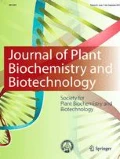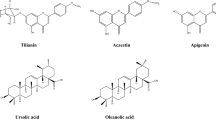Abstract
Ammi majus L. (Apiaceae), an important medicinal herb, constitutes the principal commercial source of xanthotoxin that is commonly used in leucoderma. Since the seed set and germination is poor, the present investigation was undertaken to propagate A. majus through tissue culture and monitor the yield of xanthotoxin (furanocoumarin) in the resultant callus and plantlets. The callus obtained from the cotyledonary leaves on MS medium supplemented with indoleacetic acid (IAA) + kinetin (Kn) + casein hydrolysate (CH), differentiated shoot buds on a medium additionally enriched with adenine. Plantlets 3.5 cm tall, resulted upon transfer of shoots to MS medium with indolebutyric acid (ISA) and glutamine. These plantlets flowered in vitro. The yield of xanthotoxin detected in regenerating cultures is more than hitherto reported from any other tissue including the seeds. lsozymes profile for leucineaminopeptidase (LAP), esterase and peroxidase could be used as reliable markers for the characterization of various stages of growth of callus and regenerants. The present report would prove advantageous in multiplication of Ammi majus and also in inducing enhanced levels of xanthotoxin.
Similar content being viewed by others
Abbreviations
- MS:
-
Murashige and Skoog’s medium
- IAA:
-
Indole acetic acid
- Kn:
-
Kinetin
- CH:
-
Casein hydrolysate
- IBA:
-
Indolebutyric acid
- BAP-6:
-
Benzylaminopurine
- LAP:
-
Leucineaminopeptidase
- TLC:
-
Thin layer chromatography
- HPLC:
-
High performance liquid chromatography
References
Nielsen BE, In Biology and chemistry of Umbelliferae (VH Heywood, Editor) Academic Press, London (1971) P 325.
Fahmy IR & Abu-Shady H, Q J Pharm Pharmacol, 20 (1948) 281.
Wolff FA & Tessa TV, Clin Pharmacokinet, 11 (1986) 62.
Ben-Hur E & Pill-Soon S, Adv Radiat Biol, 2 (1984) 131.
Rodigiero G, Farm Ed Prat, 40 (1985) 172.
Vuorela H, Tornquist K, Nyiredy Sz, Sticher O & Hiltunen R, In 36th Yearly Congr Soc Med Plant Res Abstr Freiburg, Thieme, Stuttgart (1988) p 44.
Trojanek J, Hodkova J & Cekan Z, Planta Med, 9 (1961) 200.
Ekiert H, In Biotechnology in agriculture and forestry (YPS Bajaj, Editor) Springer-Verlag, Berlin (1993) p 1.
Scandalios JG, Ann Rev Plant Physiol, 25 (1974) 225.
Murashige T & Skoog F, Physiol Plant, 15 (1962) 473.
Srivastava PS & Steinhauer A, Plant Sci Lett, 22 (1981) 379.
Shaw CR & Prasad R, Biochem Genet, 4 (1970) 297.
Tarpo E, Gheorghiu M & Contz O, Farmacia, 13 (1965) 331.
Blazek Z, Farm Obz, 35 (1966) 494.
Constable F, Planta Med, 56 (1990) 421.
Lee RR, Can J Bot, 50 (1972) 2471.
Author information
Authors and Affiliations
Rights and permissions
About this article
Cite this article
Purohit, M., Pande, D., Datta, A. et al. In Vitro Flowering and High Xanthotoxin in Ammi majus L.. J. Plant Biochem. Biotechnol. 4, 73–76 (1995). https://doi.org/10.1007/BF03262956
Revised:
Published:
Issue Date:
DOI: https://doi.org/10.1007/BF03262956




